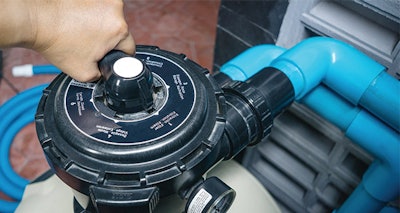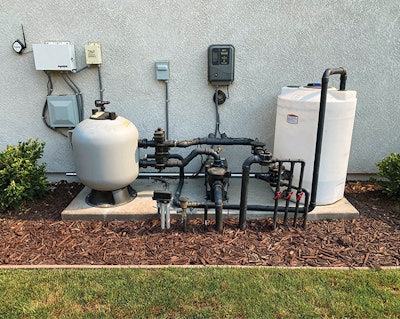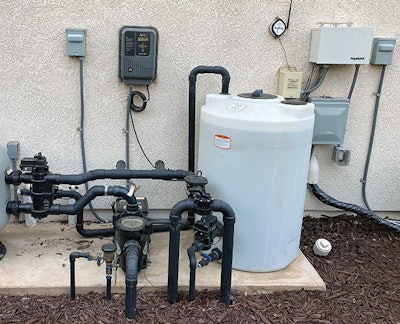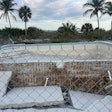
All over the world, millions of sand filters are regularly backwashed to clear out the dirt that has accumulated in the course of normal operation. This sand filter flushout process may use 200 gallons of water or more, depending on who is doing it and how long it takes to run clear. That 200-gallon backwash is 99% clean water, and a relatively small amount of dirt.
The dirt is waste, but the water that carries it away is valuable. It started out as part of our limited, precious freshwater supply; it was treated and pumped to the pool, where it was treated again, with fairly expensive chemicals, and perhaps heated to a higher temperature with fossil fuels. After all that, in a 5-minute backwash, it's poured down the drain in order to haul out the trash.
This happens every day on a grand scale. There are more than 1 million sand pool filters in the Western U.S. alone. A little math — call it a 200 gallon backwash and 25 backwashes per year — shows a loss of 5 billion gallons of fresh, clean, treated water every year. That's enough water for 100 million people to take a bath.
RELATED: Sand Filters: Tips for Top Performance
Dumping all that heated, treated water on the ground is a disappointing waste. It's more than just disappointing in some areas of the Southwest where water conservation is becoming an existential issue.
However, out in the Central Valley of California, east of the Bay Area, Harold Tapley, CEO/president of Aquos Pools, has figured out a way to save sand filter backwash.
The basic idea is to backflush the sand filter as usual to get all the debris out of the sand, but then decant the clean water away from the debris and return it to the pool. Here's the best part: His system does it automatically. You never touch anything. You don't even have to turn on the pump or flip the backwash valve.
 Tapley's backwash saving invention — full system view.
Tapley's backwash saving invention — full system view.
FLUSH IT BACK
Mr. Tapley has spent his life as a pool builder; learned it as a boy from his father. He is an inventor by nature. He's always thinking about ways to improve pool technology. Filter backwash got his attention years ago because he didn't like the wasted water, and he didn't like dumping salt water from salt pools on the ground because of the pollution it caused.
"I really was against salt systems for that reason, but this system solves that problem where we're not dumping the water on the ground — we're actually containing it and reusing it," he says.
To build his backwash saving system, Tapley just used parts from his local distributor. "Any SCP in the U.S. would have the parts. You just need to be able to put it together. I've been thinking about licensing the recycling method, and I have a patent pending, but basically, it just uses the same concept they use for DE filter separation tanks."
He's just being modest. There is a key difference. His system is automatic. You practically never need to touch it or even clean out the sand from the filter.
"Sand is not the greatest for cleaning," he says. "It's gotta be shoveled out periodically, just like the cat box (if you have a cat, you know what I mean). But you know, in this day and age, nobody wants to clean out the cat box, just the same as nobody wants to clean out the sand filter. So I'm like, okay, how do we make this thing so you don't have to dig a bunch of crud out of it?"
It starts with the filter media. Tapley eschews ordinary sand — "it just doesn't filter that well. It channels. It clumps," he says — for glass filter media. Specifically, Activated Filter Media is treated to prevent bacterial growth and channeling in the sand bed, and according to Tapley, captures particles all the way down to one micron for great water clarity. In addition, he says, it retains its filtering edges a lot longer than sand, which wears down and has to be replaced.
RELATED: Filter Media: Glass Gains
Once a day, all that particulate debris, from the gross to the fine, is automatically backwashed out of the filter. That is, a digitally controlled actuator flips the backwash valve, revs up the pump, and water starts reversing out. This filthy, cloudy water fills a tank next to the filter. Here, in the separation tank, the dirt falls to the bottom, the water in the upper 80% of the tank clears, and is recirculated back to the filter, where it is finecleaned and returned to the pool.
"We just let the crud settle out, and put the water back into the pool," Tapley says. "Originally, I thought we'd backwash our system once a week — that's more than anybody else is doing, right? But then I got to thinking about it. I'm like, okay, right now it's 105 degrees outside. And in a tank that's translucent, if the water sits there, it's going to start to turn green because the chemicals will burn off pretty quickly. So we went to a 24-hour cycle where we backwash every day. Which keeps fresh, chemically treated water throughout the system so we don't have a problem with the tanks turning green or anything like that.
"We use a translucent sediment tank because we want to see the water levels and see what's going on, but the bottom line is we're able to capture the sediment, allow the water to recycle right back through the filter again, so anything that does not drop out in the sediment gets filtered again. And tomorrow it's going to go right back in there again."
 Translucent sedimentation tank, nearly full of decanting backwash.
Translucent sedimentation tank, nearly full of decanting backwash.
PERFORMANCE
How does it work? If you go to the Aquos Pools website, you see that sparkling clean water is the No. 1 feature the company advertises for its pools. It has branded its overall approach as the "e3pool" — ecosmart, efficient and effortless.
"Well, we've got about 250 units installed and functioning right now out in the field," Tapley says, "and it's working great. I use it on my own pool. Along with saving all that water and being easier because it's automatic, it also dramatically lowers your pool's use of chlorine. My chlorine levels are crazy low, even though I keep my pool at 92 degrees (that's the way my wife likes it).
"At that temperature, when it's 105 outside like it is right now, you'd think the pool would use a lot more chlorine — but I keep my salt generator set on 20%. In the winter time I keep it at 10%, with a salt level at 1900 ppm.
"Now, it helps that I run the pump 24 hours a day down at 800 to 1100 RPM, which gives you better filtration and saves electricity. But basically, with the glass media and this filtration system, we've removed so much dirt and debris from the pool, you just don't need as much chlorine."
RELATED: Eco-Friendly Pool Draining
Another plus, Tapley says, is by automating flow and filtration, his company gets fewer flow-related callouts from customers. In his area in particular, he says, "heater won't fire" calls due to clogged filters can be a very common problem.
"On our pools with the automatic backflush system, we don't get those calls any more because the filter is always clean. We used to get that heater won't fire call, and we'd say:
"You didn't clean your filter."
"Yes, we did."
"No, you didn't. Your filter's dirty, your water flow's not there, and that's why your heater won't fire."
"And we'd send somebody out, and they'd just rinse off the outside of the cartridge filter or backflush the sand filter or whatever, and the heater'd fire right up. And they're like, 'Wow. Are there any other options?' And we say, 'Well, yeah, I can put this system on your pool, you don't have to take it apart and clean it or anything, and your heater won't shut down anymore because your filter will stay clean.'"
Though Tapley hopes to patent a system in the U.S., there is a similar system in use across the Pacific, from a company called Backwash Recyclers Australia.
"They've actually been using tanks to recycle backwash because of the severe drought issues they have," Tapley says, "so the concept has been proven there. They don't have a patent in the U.S., and the system is manual.
RELATED: Filtration Nation
"The system you see in the pictures is a two-tank design, but my patent application includes the concept of an automatic system that functions with a single tank design — with filter and the tank all in one unit, so it won't have as large of a footprint — that's important here in California and elsewhere."
AWARDS AND FULFILLMENT
There are many motivations for cutting water waste in the pool industry. For homeowners, it saves money and makes products more attractive and affordable. For industry members, it helps deflect the attention of state governments in drought-stricken areas who are taking steps to curtail water use. And for everyone else, it furthers the goal of conserving the limited resources of this planet.
A lesser motivation, but still one of importance, is an award from one of the organizations trying to stimulate and reward people like Harold Tapley to figure out water conservation. One of these, Imagine H2O, is a non-profit that provides grants for inventions that save water like Mr. Tapley's. At the time this article went to press, final selections were being made.
"Within the next month, they're deciding I guess what you could call the winners, so we're hoping to be among them," Tapley says, with an eye toward transitioning operations to his kids. "I would like to be able to get this system patented and find somebody that would gear it up for production and marketing. That's what I would consider to be my retirement fund."












































